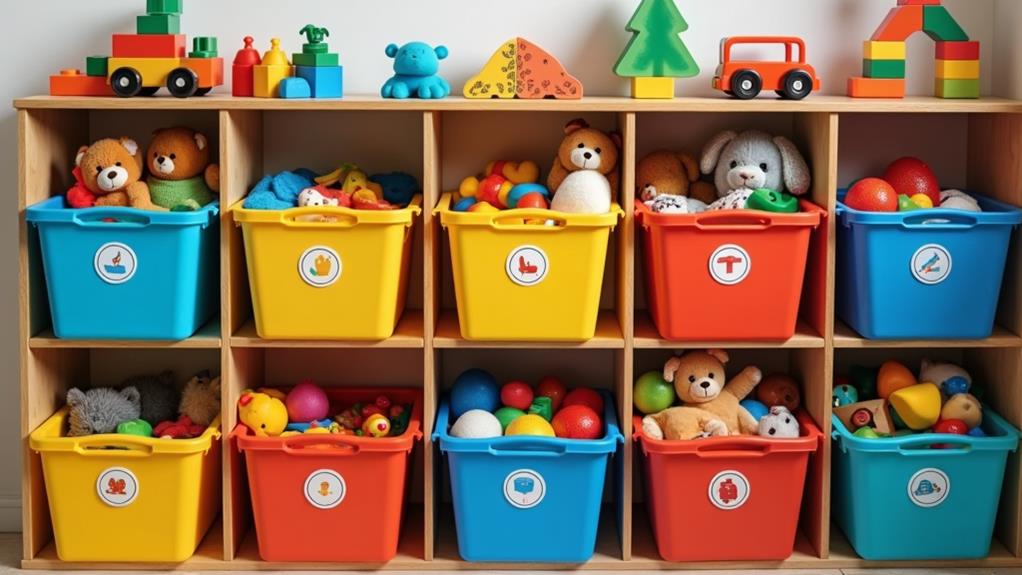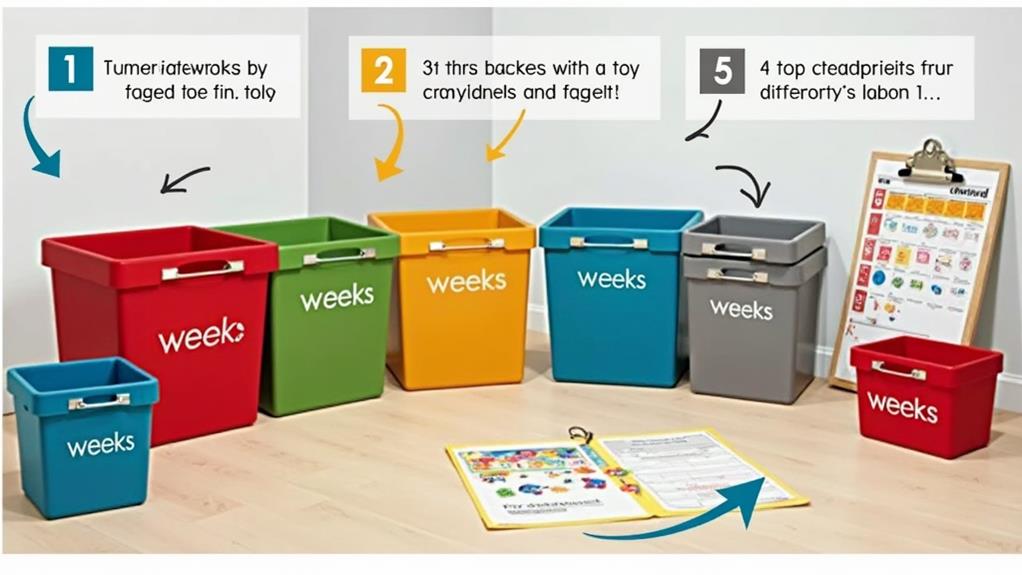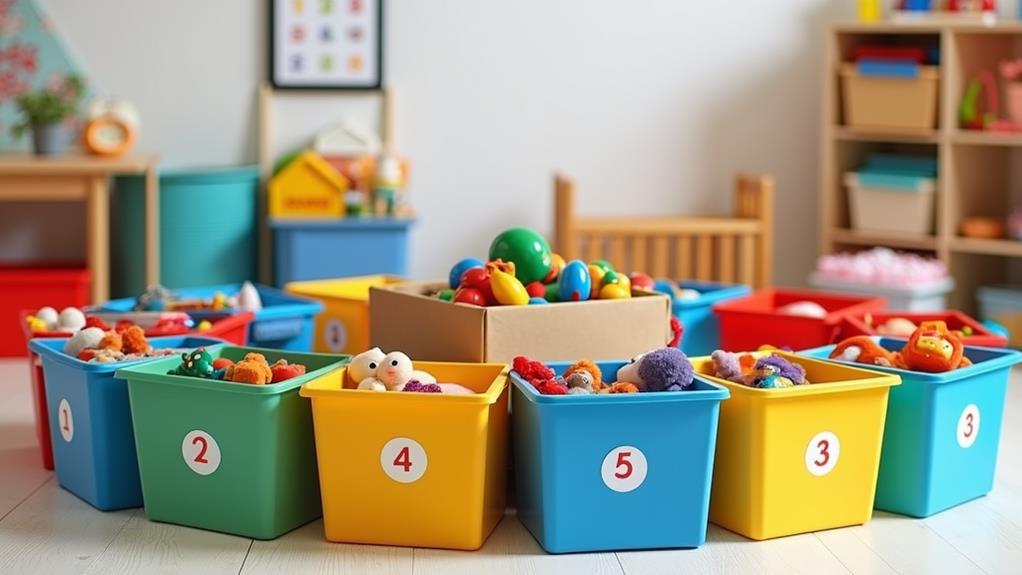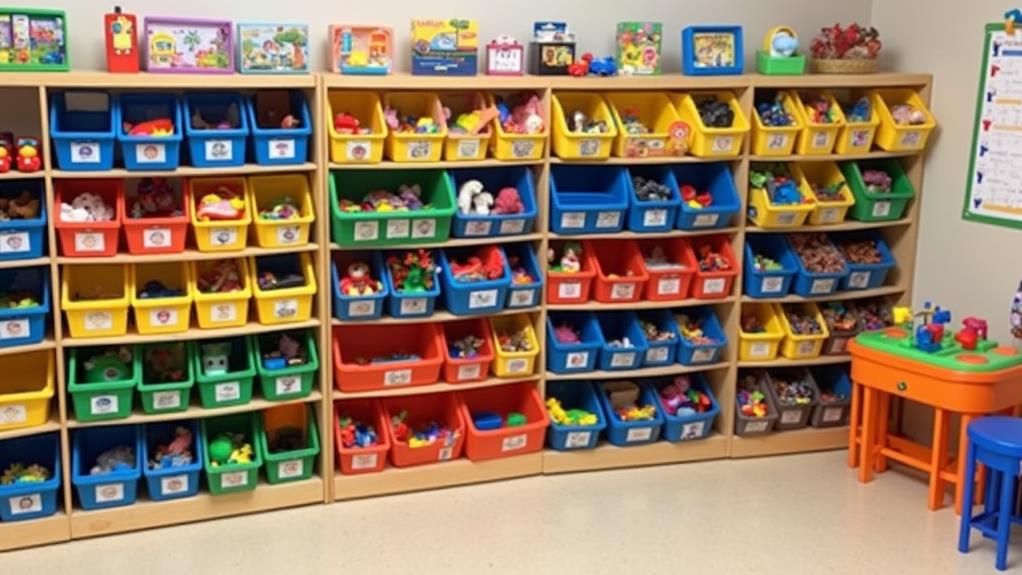Ready to tame the toy tornado? Organizing for an effective toy rotation system is a game-changer, mama! Start by decluttering – out with the unloved, in with the cherished. Categorize those playroom treasures: fine motor, pretend play, you name it. Clear bins are your new best friend for easy access and visibility. Set a rotation schedule that works for your littles, whether it's daily for toddlers or weekly for older kiddos. Get the kids involved in the process – it's like a treasure hunt every time! Maintain the system by regularly evaluating and swapping out toys. Trust me, your sanity (and your living room floor) will thank you. Want to dive deeper into toy rotation magic?
Quick Takeaways
- Declutter and sort toys, keeping only those that bring joy and have play potential.
- Categorize toys into groups like fine motor, large motor, pretend play, and dress-up.
- Choose appropriate storage solutions such as clear containers and labeled bins for organization.
- Create a rotation schedule based on children's ages and play patterns.
- Involve children in the process to foster responsibility and maintain their interest in toys.
Understanding Toy Rotation Benefits
Five key benefits make toy rotation a game-changer for parents and children alike. You'll be amazed at how this simple organization trick transforms your kids' play space! First, it's like magic for engagement. Your little ones will play 60% longer with a curated toy selection. Say goodbye to overwhelming toy clutter! And moms, listen up: 70% of us feel less stressed with an organized play area. Isn't that a refreshing change? Implementing storage solutions like the OLIXIS Dresser or Delta Children Multi-Bin Toy Organizer can greatly enhance your toy rotation system, making it even more effective and visually appealing.
But wait, there's more! Rotating toys revives forgotten favorites. Your kids will rediscover old gems with 85% more enthusiasm. Plus, you'll save money and reduce consumption by 30%. Who doesn't love that? Finally, limiting toys to 4-6 at a time makes clean-up a breeze. Your kiddos will learn responsibility while you enjoy a tidier home. Win-win
Decluttering Your Toy Collection
Before diving into toy rotation, you'll need to declutter your existing collection. Oh, mama, I know it's tough, but trust me, it's worth it! Start by gathering all those toys in one spot. It's like a toy explosion, right? But don't panic! Now's your chance to assess what you've got and organize for an effective toy rotation system. Consider using clear storage solutions to make it easier for both you and your kids to see what's available and keep things tidy.
Sort toys into keep, donate, and trash piles. Be ruthless! That broken fire truck? Bye-bye! Outgrown baby toys? Time to go! Involve your kids in this process – it'll teach them responsibility and might even be fun. (Crazy, I know!)
Use a checklist to help you decide what stays. Does it spark joy? Does it encourage creative play? Keep those gems! And remember, decluttering isn't a one-time thing. You've got this, mama
Categorizing Toys for Rotation

Now that you've decluttered your toy collection, it's time to sort what's left into categories. Trust me, categorizing toys will be a game-changer for your toy rotation system! Start by grouping items into categories like fine motor, large motor, pretend play, and dress-up. Oh, the joy of seeing your play area transform! Consider using versatile storage solutions like multi-bin organizers to keep categories separate and easily accessible. These can also help encourage kids to participate in cleanup.
Balance is key, mama. Assess your toy categories and donate duplicates or rarely-used items. You'll free up storage space and keep things fresh. Why not use themed bins for seasonal or character-based toys? It's a fun way to spark imagination!
Don't forget to mix it up! Include a variety from each category in your rotation. And hey, keep an eye on what your little ones love. Their interests change faster than you can say "toy category"! Adjust your rotation accordingly, and watch their playtime soar
Choosing Appropriate Storage Solutions
Choosing the right storage solutions is essential for an effective toy rotation system. Clear plastic containers are a game-changer, mamas! They'll let you and your little ones see what's inside at a glance. But don't stop there – mix it up with labeled bins and baskets to keep those play areas organized and clutter-free. And here's a sanity-saving tip: store some containers out of reach. Trust me, it'll prevent toy avalanches and make rotating toys a breeze. Multi-functional organizers with wheels can provide versatile storage for both toys and sports gear, making it easier to move items around as needed.
Want to maximize space? Cube shelves are your new best friend! They're perfect for stacking storage containers and make it easy to rotate toys efficiently. Oh, and don't forget to label everything. Grab a permanent marker or some fun duct tape and get creative! Your kiddos will love being able to find and put away their toys independently. Isn't that what we're all aiming for
Creating a Rotation Schedule

Once you've got your storage solutions sorted, it's time to tackle the rhythm of your toy rotation. Let's create a schedule that'll make your little one's playtime magical! For the tiniest tots, daily rotations work wonders, while toddlers thrive on weekly or bi-weekly swaps. But here's the secret sauce: monitor children's play patterns and adjust accordingly. You're aiming for that sweet spot – a balance of novelty and familiar favorites.
Why not make toy rotation day a special event? Get the kiddos involved in choosing what to swap out. It's like Christmas morning every time! And don't forget to keep track with a calendar or chart. Trust me, it's a lifesaver when mom-brain kicks in. Remember, this isn't set in stone. Reassess and tweak to optimize play experiences. Your little ones will thank you!
Involving Children in the Process
Countless parents overlook a golden opportunity when it comes to toy rotation: involving their children in the process. By engaging your little ones, you'll foster a sense of responsibility and make the whole experience more fun! Let your kids help select which toys to keep out and which to store away. This builds anticipation for "new" toys when they're rotated back in.
Want to make it even more exciting? Try organizing toys into themed bins together. It's a great way to develop sorting skills and simplify the rotation process. Here's a quick guide to get you started:
| Theme | Examples | Rotation Frequency |
|---|---|---|
| Building | Blocks, Legos, Magnets | Every 2 weeks |
| Pretend Play | Dolls, Kitchen Set, Cars | Monthly |
| Arts & Crafts | Crayons, Play-Doh, Beads | Weekly |
| Educational | Puzzles, Flash Cards | Bi-weekly |
Involving children in cleanup routines instills positive habits and makes toy management a breeze. It's a win-win!
Maintaining the Rotation System

Maintaining a toy rotation system requires consistency and a bit of strategy. Every time you put away toys being packed away, take a moment to assess their condition and your child's interest level. To maintain an effective toy rotation system, swap out toys every 1-2 weeks for little ones and 3-4 weeks for older kids. Keep toys organized in clear bins or a designated closet space, making it easy to see what's available. And hey, mama, don't forget to involve your kiddos in the process! Let them choose which new toys to bring out – it's like Christmas morning all over again!
But how do you keep track of it all? A simple chart or list can work wonders. Jot down which toys are in rotation and when they were last used. Trust me, your future self will thank you!
Adapting to Changing Needs
Flexibility is key when it comes to adapting your toy rotation system to your child's changing needs. You'll want to regularly reassess and adjust as your little one grows. Monitor signs of boredom or frustration with the current selection – it's time to rotate when engagement levels drop!
| Age Group | Toys to Rotate | Rotation Frequency |
|---|---|---|
| Toddlers | 4-6 toys | Every 3-7 days |
| Preschool | 6-8 toys | Every 7-10 days |
| School-age | 10-15 toys | Every 10-14 days |
Involve your child in the selection process. It's a great way to foster responsibility and ownership. As you rotate, consider incorporating seasonal themes or special occasions to keep the play room exciting. Remember, one toy out, one toy in! And don't forget to adapt to their developmental stages. Old toys might suddenly become fascinating again, so keep an open mind!
Common Questions
How Many Toys Should Be Out for Toy Rotation?
You should keep 4-6 toys out per play space for ideal engagement. For toddlers, rotate 1/3 of their toys while storing 2/3 away. Aim for 10-15 manageable toys overall. Adjust rotations every 1-2 weeks based on your child's interest.
How to Do Montessori Toy Rotation?
You'll find Montessori toy rotation simple yet effective. Select 4-6 age-appropriate toys, organize them by skill category, and swap them every 1-2 weeks. Involve your child in choosing toys, and use clear bins for easy access and cleanup.
How Do I Organize My Toy Collection?
You'll want to gather all your toys, sort them into categories, and store them in labeled bins. Keep 10-15 toys accessible, rotating others every couple of weeks. Involve your kids in the process and regularly assess your collection.
How to Segregate Toys?
To segregate toys, you'll want to sort them into clear categories. Group similar items together, like building blocks, dolls, or vehicles. Use labeled bins or shelves for each category, making it easy to find and put away toys.




